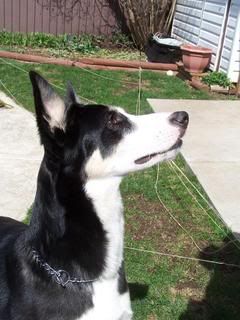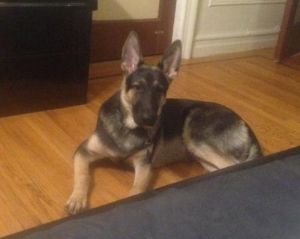 Re: How to know when a dog knows a command
[Re: steve strom ]
#383945 - 10/09/2013 03:13 PM Re: How to know when a dog knows a command
[Re: steve strom ]
#383945 - 10/09/2013 03:13 PM |
Webboard User

Reg: 10-01-2013
Posts: 343
Loc: nyc
 Offline Offline |
|
Because if you just put on a prong and don't use it the right way, its just another problem you'll have.
can you explain please? everyone is saying "the minute i put it on my dog stopped pulling".
i'm not seeing that, my dog pulls, chokes and pulls so i start speeding up so that he stops choking until i cant speed up anymore.
then we stop, start over, repeat....
|
 Top Top
|
 Re: How to know when a dog knows a command
[Re: Natalie Rynda ]
#383946 - 10/09/2013 03:14 PM Re: How to know when a dog knows a command
[Re: Natalie Rynda ]
#383946 - 10/09/2013 03:14 PM |
Webboard User

  
Reg: 09-23-2011
Posts: 2692
Loc: Marrero, LA
 Offline Offline |
|
Write a manual. Jot down everything you've seen and heard to date, and organize it. First make an outline, then draft it out. Worked for me in college!

Sadie |
 Top Top
|
 Re: How to know when a dog knows a command
[Re: Duane Hull ]
#383947 - 10/09/2013 03:18 PM Re: How to know when a dog knows a command
[Re: Duane Hull ]
#383947 - 10/09/2013 03:18 PM |
Webboard User

Reg: 10-01-2013
Posts: 343
Loc: nyc
 Offline Offline |
|
Natalie, JMHO, I have ahighly reactive dog who would act like that if I gave her a chance. I have to control her environment to stem the reactivity. If she's going to be a hot mess at the park, guess what? That's right.
If I want to go to Petco to see if I can proof some desensitizing, I pick a time when there is low traffic, and am always ready to abort.
With a reactive dog, any outing should include some desensitizing and a backup plan.
he needs exercise, that's the only place he can get it at. it's not a dog park, just a regular very large park with off leash hours, we stay away from everyone else but sometimes dogs pass by or run up to him.
also, i can't predict what dogs are walking down the street and sometimes i won't see them coming fast enough (around the corner) so things will happen.
i do my best.
what's your backup plan?
and i think i'm doing desensitizing the way i described, standing on a busy corner and stuffing treats in him
|
 Top Top
|
 Re: How to know when a dog knows a command
[Re: Duane Hull ]
#383948 - 10/09/2013 03:20 PM Re: How to know when a dog knows a command
[Re: Duane Hull ]
#383948 - 10/09/2013 03:20 PM |
Webboard User

Reg: 10-01-2013
Posts: 343
Loc: nyc
 Offline Offline |
|
Write a manual. Jot down everything you've seen and heard to date, and organize it. First make an outline, then draft it out. Worked for me in college!
i am and i'm not even joking)))))
that's why i'm starting all these threads (here and before on the other board), i pick out the things i like and put them in a document on my phone.
i also have all Ed's articles on my phone and reread them every few weeks
it really helps
|
 Top Top
|
 Re: How to know when a dog knows a command
[Re: Natalie Rynda ]
#383949 - 10/09/2013 03:36 PM Re: How to know when a dog knows a command
[Re: Natalie Rynda ]
#383949 - 10/09/2013 03:36 PM |
Webboard User

  
Reg: 03-17-2006
Posts: 4203
Loc:
 Offline Offline |
|
Because if you just put on a prong and don't use it the right way, its just another problem you'll have.
can you explain please? everyone is saying "the minute i put it on my dog stopped pulling".
i'm not seeing that, my dog pulls, chokes and pulls so i start speeding up so that he stops choking until i cant speed up anymore.
then we stop, start over, repeat....
Taking them in stride, to me sounds like he's ignoring them. If he's still pulling till he chokes on a prong, I think its because he's figured out that if he pulls hard enough to have a tight leash, the prong isn't anymore uncomfortable then any flat collar.
A correction with a prong is a quick pop and release that interrupts something. If the leash is tight, what you're probably doing is just jerking him around and that could be another reason he's pulling like he does. Its all related.
|
 Top Top
|
 Re: How to know when a dog knows a command
[Re: Natalie Rynda ]
#383950 - 10/09/2013 03:40 PM Re: How to know when a dog knows a command
[Re: Natalie Rynda ]
#383950 - 10/09/2013 03:40 PM |
Webboard User

  
Reg: 09-23-2011
Posts: 2692
Loc: Marrero, LA
 Offline Offline |
|
My backup plan includes an escape route and a stick for warding off unwanted advances.
The minute I see a potential problem (ears going up, or other signs that I'm used to reading in my dog), I add proper distance, which has been determined during desensitizing. I redirect focus to me, and I work on engagement until we have left the distraction behind.
As far as the park, a dog on a 30ft tether is not exercising. The tether creates barrier aggression and increased territoriality. BAD IDEA! The dog is much more comfortable leashed to you, with you there to show him that you are protecting him. I would seriously find another place to exercise.

Sadie |
 Top Top
|
 Re: How to know when a dog knows a command
[Re: Natalie Rynda ]
#383951 - 10/09/2013 03:40 PM Re: How to know when a dog knows a command
[Re: Natalie Rynda ]
#383951 - 10/09/2013 03:40 PM |
Webboard User

  
Reg: 12-08-2005
Posts: 1271
Loc: Stoney Creek , Ontario, Canada
 Offline Offline |
|
Prongs can actually AMP up a dog and make his reactivity worse.
You really have to know what you're doing to use a prong properly and the way it was meant to be used.
It's a great tool in the right situations. If you try to pop the dog at the wrong time all you're going to do is rile him up even more, which to me, sounds like thats what's already happening.

Don't complain....TRAIN!!! |
 Top Top
|
 Re: How to know when a dog knows a command
[Re: Natalie Rynda ]
#383953 - 10/09/2013 03:42 PM Re: How to know when a dog knows a command
[Re: Natalie Rynda ]
#383953 - 10/09/2013 03:42 PM |
Webboard User

  
Reg: 09-23-2011
Posts: 2692
Loc: Marrero, LA
 Offline Offline |
|
Cutting and pasting on the computer is not as reinforcing as actual technical writing. Writing something down and manually reorganizing is extremely reinforcing.

Sadie |
 Top Top
|
 Re: How to know when a dog knows a command
[Re: Duane Hull ]
#383954 - 10/09/2013 03:45 PM Re: How to know when a dog knows a command
[Re: Duane Hull ]
#383954 - 10/09/2013 03:45 PM |
Webboard User

Reg: 10-01-2013
Posts: 343
Loc: nyc
 Offline Offline |
|
My backup plan includes an escape route, a stick for warding off unwanted advances.
The minute I see a potential problem (ears going up, or other signs that I'm used to reading in my dog), I add proper distance, which has been determined during desensitizing. I redirect focus to me, and I work on engagement until we have left the distraction behind.
As far as the park, a dog on a 30ft tether is not exercising. The tether creates barrier aggression and increased territoriality. BAD IDEA! The dog is much more comfortable leashed to you, with you there to show him that you are protecting him. I would seriously find another place to exercise.
he's on a tether because i don't want to risk him running up to someone or someone's dog and barking at them and something happening, so until his recall is solid he's tethered.
i used to have him tethered to me and i still can do that but then we'd both get tangled in the line and i don't see the difference of him tethered to me or the tree.
i am always a few feet away from him, how is this different from him being tethered to me?
the reason i started doing a tree is so that i can play the flirtpole without tripping over the line. since i flirt by moving him in circle it always became one big mess.
if i can find another place i would've done it a while ago, i have many problems in that park. but i can't, that's the only place that i can go to every day.
it IS exercising, compared to the other choice (walking the streets for 2 hours) it's definitely exercising. he gets to run and jump.
|
 Top Top
|
 Re: How to know when a dog knows a command
[Re: Duane Hull ]
#383955 - 10/09/2013 03:48 PM Re: How to know when a dog knows a command
[Re: Duane Hull ]
#383955 - 10/09/2013 03:48 PM |
Webboard User

Reg: 10-01-2013
Posts: 343
Loc: nyc
 Offline Offline |
|
Cutting and pasting on the computer is not as reinforcing as actual technical writing. Writing something down and manually reorganizing is extremely reinforcing.
it's reinforcing enough))))) i have to go trough the text many times over to pick out the pieces i want and organize them into small cheat sheets.
it's working for me.
what am i going to do with all that paper, especially when i'm outside? it's MUCH easier working with text in an electronic format.
|
 Top Top
|
When purchasing any product from Leerburg Enterprises, Inc. it is understood
that any and all products sold by Leerburg Enterprises, Inc. are sold in Dunn
County Wisconsin, USA. Any and all legal action taken against Leerburg Enterprises,
Inc. concerning the purchase or use of these products must take place in Dunn
County, Wisconsin. If customers do not agree with this policy they should not
purchase Leerburg Ent. Inc. products.
Dog Training is never without risk of injury. Do not use any of the products
sold by Leerburg Enterprises, Inc. without consulting a local professional.
The training methods shown in the Leerburg Ent. Inc. DVD’s are meant
to be used with a local instructor or trainer. Leerburg Enterprises, Inc. cannot
be held responsible for accidents or injuries to humans and/or animals.
Copyright 2010 Leerburg® Enterprises, Inc. All rights reserved. All photos and content on leerburg.com are part of a registered copyright owned by Leerburg Enterprise, Inc.
By accessing any information within Leerburg.com, you agree to abide by the
Leerburg.com Privacy Policy and Terms of Use.
 Previous Topic
Previous Topic Index
Index Next Topic
Next Topic












 Top
Top



.jpg)

.jpg)